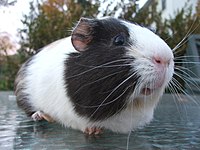
Photo from wikipedia
This experiment was conducted to investigate the effects of different starch source diets on growth performance, intestinal health, and, microbiota of growing pigs. Eighteen healthy "Duroc × Landrace × Yorkshire" pigs (50 ± 0.61 kg, Castrated boar)… Click to show full abstract
This experiment was conducted to investigate the effects of different starch source diets on growth performance, intestinal health, and, microbiota of growing pigs. Eighteen healthy "Duroc × Landrace × Yorkshire" pigs (50 ± 0.61 kg, Castrated boar) were randomly divided into three groups with six replicates and one pig per replicate. The pigs in the three treatments were fed diets prepared with cassava flour (CF), rice bran (RB) and sorghum flour (SF), respectively, and the nutritional levels of the three treatments were the same. The experiment lasted for 28 days. The results showed that pigs in the RB group had significantly increased average daily gain (ADG, p < 0.05) compared with pigs in CF and SF groups. Compared with pigs in the CF group, the final body weight (FBW) of growing pigs in the RB group was increased and the ratio of feed to gain (F: G) was decreased (p < 0.05). There was no significant difference between FBW and F: G between the SF group and the other two groups. Compared with the CF group, the RB group significantly increased the jejunum amylase activity (p < 0.05), and there was no significant difference between the SF group and the other two groups. Compared with growing pigs in the CF group and SF group, the duodenal villus height and villus height/crypt depth ratio of growing pigs in the RB group were significantly increased (p < 0.05). The concentrations of acetic acid, propionic acid, and total VFA in the colon and caecum of piglets in the SF group were significantly increased (p < 0.05) compared to piglets in CF and RB groups, and there was no significant difference between the CF group and RB group. Compared with the RB group, caecal butyric acid concentration was significantly increased in SF and CF groups (p < 0.05). Seven dominant phyla were identified at the phylum level, among which Firmicutes, Bacteroidota and Spirochaetota were dominant phyla, accounting for 74.18%, 14.87% and 6.56% of the RB group respectively. Cassava flour group accounted for 80.22%, 9.64% and 3.71%; Accounting for 65.33%, 17.34% and 13.07% of the SF group. Through the comparative analysis of microbial differences among the treatment groups, it was found that at the phylum level, compared with the SF group, the abundance of Synergistota in the diet of the CF group and the diet of the RB group was significantly increased (p < 0.05). The abundance decreased significantly (p < 0.05). The quantity of Desulfobacterota in the RB group was significantly higher than that in the CF group (p < 0.05). In conclusion, compared with sorghum starch and cassava starch, RB starch can improve the activity of digestive enzymes and villus height in the small intestine of growing pigs and promote the growth of pigs by protecting the intestinal health of growing pigs.
Journal Title: Journal of animal physiology and animal nutrition
Year Published: 2023
Link to full text (if available)
Share on Social Media: Sign Up to like & get
recommendations!